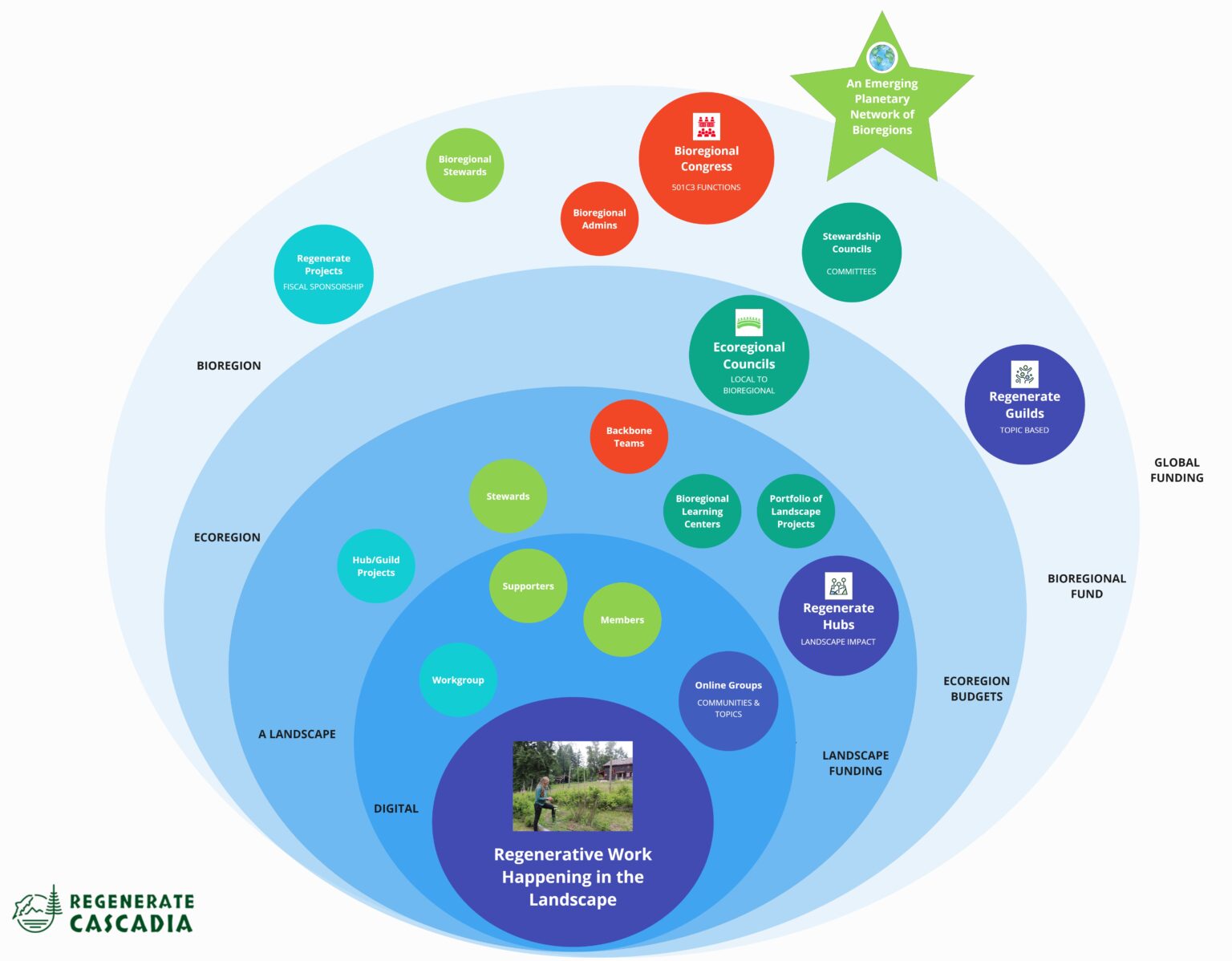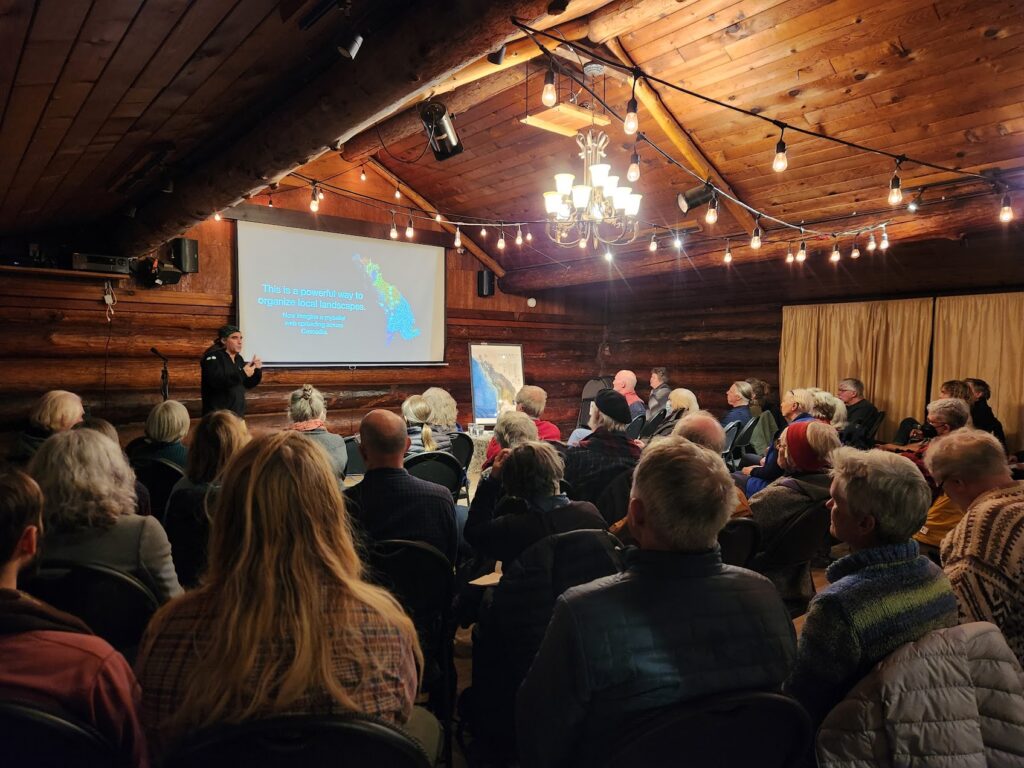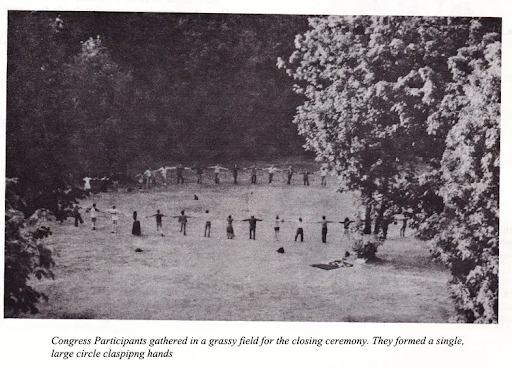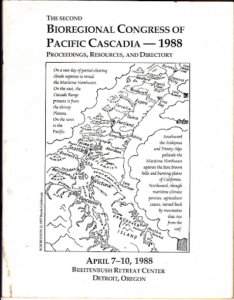Thank you for contributing your precious time and energy to Regenerate Cascadia. Cascadia is a bioregion, and a positive, vibrant, and inclusive movement that empowers every person to be active and engaged about issues they care about. Regenerate Cascadia is a 501(c)3 program of the Department of Bioregion. Our goal is for a healthy planet and culture that is regenerative, with a higher quality of living for each sequential generation of human communities, ecosystems, and species that call our bioregion home.
Our mission is to:
“To create the conditions for a regenerative culture to thrive”.

We do this work through:
Brought together in a central digital platform and website that shares information, resources, directories, updates, reportbacks, and helps connect people to issues they care about.
Lastly, this is all paired with a Regenerate Cascadia landscape fund, that can help bridge and connect work happening in the landscape with funding and support that regenerative projects, communities and leaders need, woven together on the scale of a landscape, ecoregion and bioregion – rather than individually, project by project. In a collaborative way, rather than competitive.
We firmly believe that:
“You are the change you have been waiting for.”

Regenerate Cascadia was formed by Brandon Letsinger and Clare Attwell in April 2023 during the first ever Salmon Nation Edge Prize, where their vision to activate a bioregional movement in Cascadia won the Edge Prize for Innovation in Systems and Governance. After months of planning with 100+ local community organizers on both sides of the Canada-US border, they partnered with the Design School for Regenerating Earth to co-facilitate a month-long Bioregional Activation Tour. They traveled to 14 communities around Cascadia during October 2023, hosting presentations that asked, “How do we regenerate the Cascadia bioregion?”. They met with more than 1000 individuals, including Indigenous knowledge keepers, regenerative leaders, groups, community artists, and elders across Oregon, Washington, and British Columbia through presentations, workshops, site visits, and strategy sessions. This was followed by an online summit that brought together 50+ presentations in a ‘Festival of What Works’, and concluded with an Open Space Unconference from November 3-12, 2023, where participants cocreated working groups for Regenerate Cascadia. The vision resonated strongly with many communities across the bioregion. Jay Bowen, an elder of the Skagit people who opened the Summit, articulated the following statement in the opening ceremony: “Gathered before us are the most important people in the world. It may be a small group right now, but in a few short years, there’s going to be a long line of people waiting to get involved in this very important movement that is overseeing the welfare of our communities.”
Beyond this, Regenerate Cascadia has succeeded in meeting the core challenge participatory events often struggle with—maintaining momentum and continuous engagement among participants. They have an active Telegram channel of 121 members sharing thousands of messages through 39 subchannels covering specific topics/guilds, organizational infrastructure discussions, local communities’ individual channels, media and communication, etc. The community is thriving and members are actively engaging with each other.
The Regenerate Cascadia community of ‘regenerators’ has since co-developed a digital platform to support their work; they continue to collaboratively take in feedback and refine this prototype as their ideas and needs evolve.
The digital platform includes a structural framework (see Figure 1) that prioritizes community-led work within a landscape, while thoughtfully aggregating place-based projects into larger coordination structures. A ‘front door’ website is an easy entry point for people to learn more, join as a member, donate to specific projects, and get more involved. Projects and communities each have a landing page that serve as a focal point for local news, resources, and events. These are curated by participating communities and remain indexable by search engines. The digital platform provides an online space to connect within a landscape and across watersheds at the nested scales of ecoregions and the Cascadia bioregion. The platform includes a comprehensive ‘back end’ suite of tools and resources to support local project work, including (a) education and onboarding; (b) an information commons and searchable directories; (c) a regenerative movement map and relational database; and (d) comprehensive data, measurement, evaluation and reporting capabilities. All Regenerate Cascadia programs are part of an integrated 501(c)3 nonprofit administrative backend to provide accounting, receive grants, raise funds, deliver timely financial reporting, and maintain legal compliance.
Figure 1: Regenerate Cascadia’s evolving structural framework for supporting bioregional funding
Regenerate Cascadia’s living structural framework can be viewed as a system for the coherent flow of resources (educational, financial, inspirational, and cultural) that supports ongoing bioregional regeneration outcomes and learning. The framework enables capital to be distributed from a large bioregional fund into smaller landscape-level funds that deliver resources to decentralized projects according to the needs of ecoregions and landscapes. This ensures governance power is held by those closest to the work through trust-based networks of relationships that connect and align diverse projects within a landscape-level vision and strategy. The framework provides a comprehensive intermediary between local communities and funders. This enables effective cooperation, coordination, and governance across the bioregion to optimize strategic outcomes. A key tenet is the commitment to the representation of diverse voices at all scales, including those of ecosystems and keystone species, ensuring feedback loops from across the whole system enable collective intelligence to inform future actions. This supports the whole system to see itself (co-sense), learn (co-presence), and iterate (co-create), enabling connected and concurrent local and bioregional agency to solve problems at the appropriate scales. Regenerate Cascadia’s structures are built with one of the movement’s core goals in mind—to prototype a series of replicable transformational templates that return ‘right relationship’ to the Earth as a central organizing premise for finance, while evolving how we live and work together cooperatively across scales.
A core foundation of Regenerate Cascadia are ‘Regenerate Hubs’, which hold the governance capacity to manage a fund for a discrete landscape across diverse stakeholders. Regenerate Hubs operate in several ways, including: (a) working with local communities and weaving relationships to develop a long-term vision aligned with the overall bioregional vision of Regenerate Cascadia; (b) identifying and engaging voices that need to be present; (c) maintaining a portfolio of regenerative projects within their defined landscape areas; (d) stewarding an annual landscape budget; and (e) maintaining team coherence. Each Hub has a core team that facilitates conditions for cooperation and trust and is accountable for administrative and reporting requirements. Each landscape features Bioregional Learning Centers that facilitate the cocreation of place-based frameworks and serves as foundational education space for sense-making and decision-making in the community. These centers monitor, evaluate, and manage the dynamic flow of an information commons using shared metrics for social, cultural, and ecological impact that supports robust fund reporting and continuous learning. Hubs primarily collaborate with members of Regenerate Cascadia from within a particular landscape, and are represented by a network of Ecoregional Councils—governance bodies responsible for creating ecoregional budgets that maintain the connections between local and bioregional scales.
Regenerate Cascadia’s structural framework serves several other core functions in supporting landscape leaders, including bioregional ‘Guilds’ made up of knowledge communities responsible for providing tools and resources around specific regenerative topics, and connecting learning and networks across landscapes. Hubs and Guilds undertake their own projects and activities while sharing news, updates, resources, directories, and events for a specific place or topic in a way that is meaningful for all participants. Regenerate Cascadia supports the Hubs and Guilds’ core teams and services by administering a portion of all funds raised, providing opportunities to practice healthy budgeting and governance with small sums of money, and growing their decision-making and governance capacities ahead of receiving larger flow funding. Finally, the non-profit backbone of Regenerate Cascadia is maintained through ‘Bioregional Stewardship Councils’, who directly assist with communications, outreach, fundraising, finance, legal, and reporting requirements—and a Bioregional Congress—an assembly comprised of Guilds and Ecoregional Councils to govern a shared Cascadia bioregional vision.
Each of the structural components Regenerate Cascadia is collaboratively building are demonstrable templates that are adaptable, replicable, and scalable in other localities. They are significant, not only for a single bioregion, but as a living framework for movements emerging around the world. By connecting and resourcing those doing the work in their communities through the support of core backbone teams of bioregional weavers; providing knowledge and resource sharing through Guilds that weave between landscapes; and co-creating the digital infrastructure for coordination and communication, Regenerate Cascadia enables coordinated, coherent processes for bioregional learning and regeneration. This framework provides a governance model for bioregional funding, enabling capital to flow to where it is needed on the ground and building the foundations for funding the transition to a regenerative economy.

The call to protect our bioregion is not new. In Cascadia, it sits in a broader bioregional movement that has been active since the 1970s and is now inspiring people globally to live in right relationship with the people and places where they live and has been voiced desperately by the First Inhabitants who have called this region home for more than a thousand generations.
This sentiment was articulated by Lansing Scott in 1988 in the proceedings of the second Cascadia Bioregional Congress who declared that:

These are the questions and challenges that we must face, and it is in that hope that we have gathered, not as an answer, but hopefully, to start a conversation. It is up to Cascadians, each in their way, to create and promote these changes and lead the way forward rather than wait for someone else to do it for us. This document will provide you with a basic overview of what the Regenerate Cascadia is all about and how all of us should conduct ourselves while working together.
There was a problem reporting this post.
Please confirm you want to block this member.
You will no longer be able to:
Please note: This action will also remove this member from your connections and send a report to the site admin. Please allow a few minutes for this process to complete.